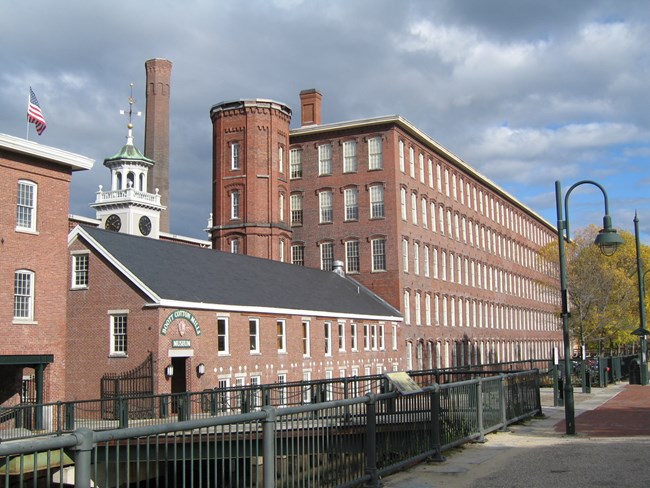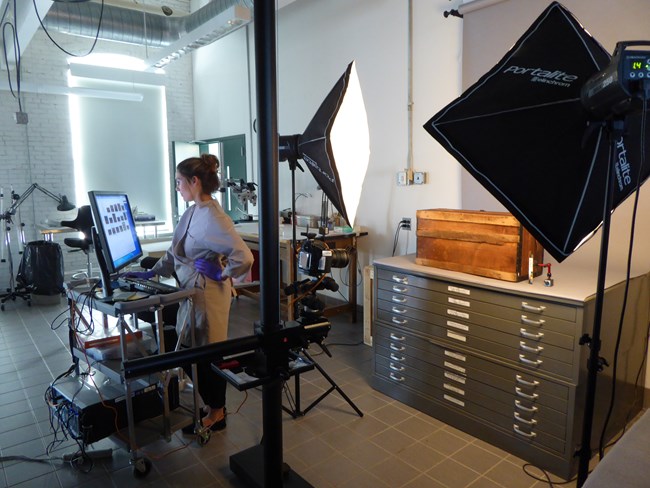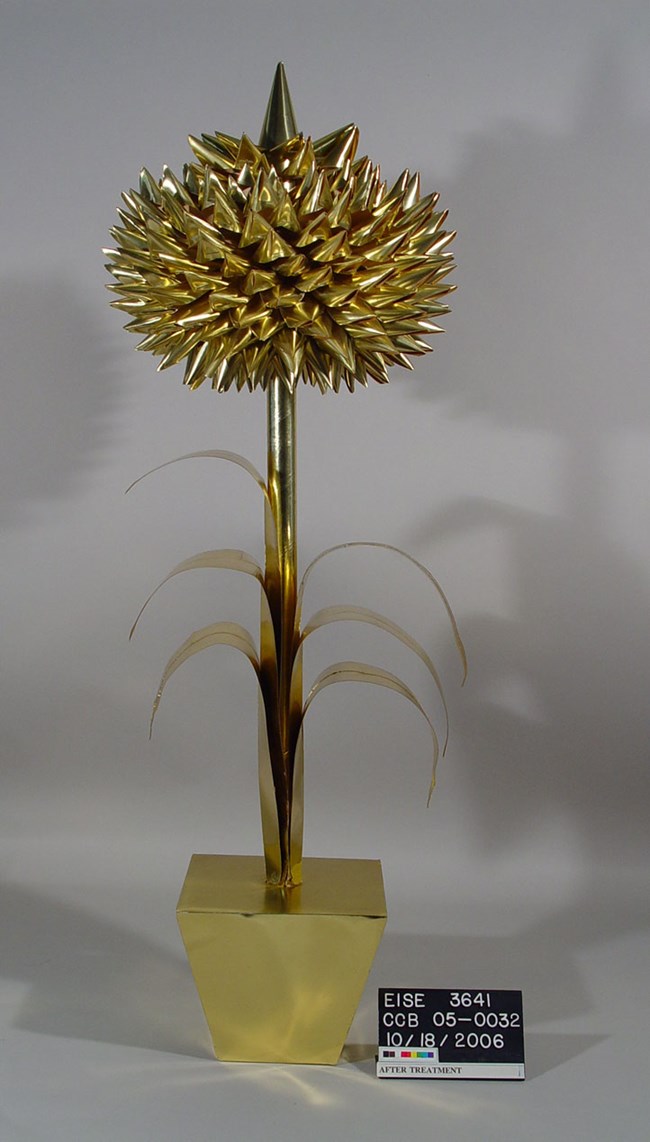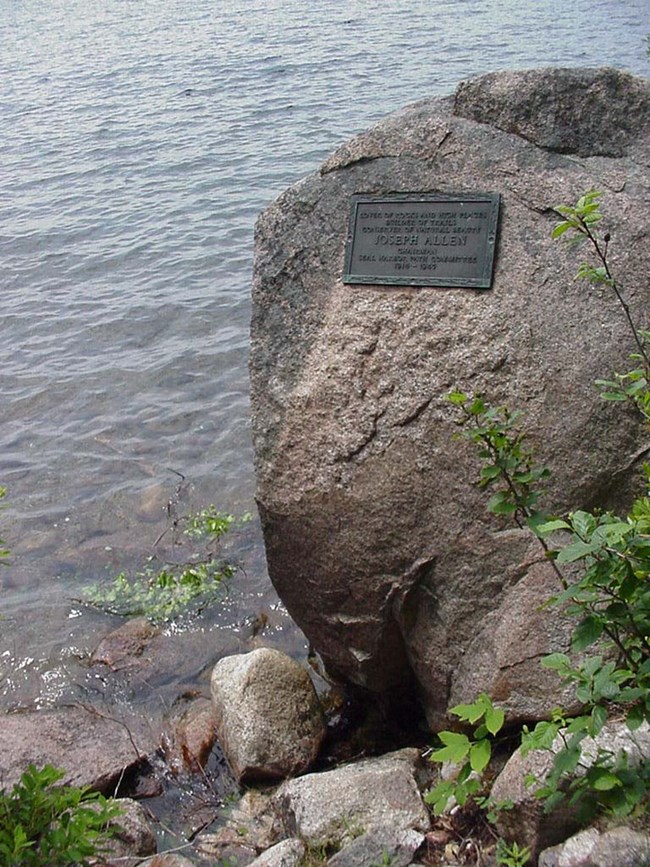Last updated: April 7, 2025
Article
Podcast 079: What the HACE?!

National Park Service
HACE: Historic Architecture Conservation and Engineering Center
Alex Beard: Hi this is Alex Beard, I’m in Lowell, Massachusetts at the National Park Service Regional office known as HACE. I’m here with the director of HACE, Stephen Spaulding. Could you tell us what HACE stands for?
Stephen Spaulding: Sure. It stands for Historic Architecture Conservation and Engineering Center. It’s a multi-discipline mixture of staff that have in one form or another been together since probably about the 1970’s. When it started off as the North Atlantic Historic Preservation Center for the North Atlantic Region which is now combined with the Mid-Atlantic and so that’s why it’s the Northeast Region.
Alex Beard: And where is HACE located?
Stephen Spaulding: Our main office is in Lowell, and that’s where we have our conservation labs, and paint lab, and mortar lab and the sort. But we also have offices in Philadelphia and New York City and Hampton, Virginia, Auburn, NY, Hyde Park, NY.
Alex Beard: And for those of you who don’t know, Lowell, Massachusetts is about 30 minutes north or so of the city of Boston. And why Lowell, Massachusetts?
Stephen Spaulding: We started off we were in Charlestown Navy yard down in a great building on the pier right next to the Constitution Museum and the workshop for the Constitution that the Navy ran and in about 1986 or so congressman Tip O’Neill got us a million dollars to move out, because they wanted our building for the Constitution Museum. And so we were actually able to become part of the development project for Boott Mills and ended up with, at that point, state-of-the-art conservation labs because of that funding.
Alex Beard: Who does HACE serve?

National Park Service
Northeast Region
Stephen Spaulding: We primarily serve the Northeast Region and probably 80% of our work load is for the small and medium sized parts. They’re the parts that really do not have the necessary technical expertise to undertake certain specialized work so we have historic architects, architectural conservators, historians, engineers, landscape architects and preservation crews. And those are the type of disciplines it’s very hard for small and medium-sized parks to keep on staff.
Alex Beard: Can someone outside the Parks Service every contact HACE for work or opinions?
Stephen Spaulding: Opinions fine, that’s pretty much how the profession works all the way across the board is you’re always reaching out to people that have expertise in some areas that you might not have yourself as far as our providing services to outside organizations, we do that with parks in other regions and sometimes we also work for organizations outside of the Parks Service but we have to be able to justify that it’s in the service of a nationally significant resource or something that has an association to a park service theme.
Alex Beard: What are some of the larger, more important parks in the Northeast Region for HACE?
Stephen Spaulding: There’s emphasis’ that occur at certain times on park resources, so for example, the final anniversary for the Civil War was the surrender at Appomattox and we basically spent five years there going through all the parks historic structures with preservation crews, contracts, working with other parks service organizations like Historic Preservation Training Center. Trying to get all the buildings into appropriate condition for the anniversary, but now we won’t be there for a while and so we’re working at other parks. Some of them that are new, some which just have a large work load backlog of preservation, reevaluation or architectural study needs.
Alex Beard: Could you shed a little bit more light on HACE and what the branches are?
Stephen Spaulding: Sure, we’re made up of four branches: Construction, Conservation, and Training which is primarily the preservation crews and hands on architectural conservators, Design and Preservation Planning which is the architects and engineers and landscape architects and the Historic Structures, Research, and Documentation Branch which oversees the list of classified structures and also is primary authors for historic structures reports in the Northeast and the Object Conservation Branch which is made up of object conservators who provide both collection condition assessments for parks and hands-on treatments.
Alex Beard: Do you know if any of the other branches of HACE have collaborated with NCPTT before and do you know how their experience was?
Stephen Spaulding: Yeah we actually, I think the first year there was an NCPTT, we did the historic structures report for the building that they’re in and so there was a relationship early on that one of the first directors used to work for what was the North Atlantic Historic Preservation Center before he went down there, John Robins we served with them in a couple of different capacities over the years. Reviewers for grant applications and for publications and the sort.
Alex Beard: Hopefully you guys work with them in the future and use some of their lab equipment and their scientific instruments that they have there.

National Park Service
Stephen Spaulding: Yes, we’re very familiar with the staff and their capabilities and so I was asked the question earlier about people contacting us for assistance, there are people on their staff that we often contact to talk over issues with technologies and techniques and so it is a collaborative relationship we just aren’t on the same path as far as working projects together.
Design & Preservation Planning
David Bitterman: Hi I’m David Bitterman, I’m chief of the Design and Preservation Planning Branch here at HACE.
Alex Beard: Hi! Could you tell us a little bit about what the Architectural Preservation department does here?
David Bitterman: Well, we have about a dozen professionals from various disciplines we have historical architects, we have landscape architects we have also various types of engineers on our staff and primarily we serve the client parks within the Northeast Region on a number of different sorts of things. First of all, we do a lot of condition assessments on historic structures, we do a lot of project formulations- or help, again client parks, with project formulations and cost estimates. We in many cases will prepare a formal design documents or projects which will be contracted out to various construction entities. We will also help procure and administer task quarters for outside architectural and engineering firms to provide design documents as well. We get involved in a number of special projects, we do materials research. We do building diagnostics, we help out with historic structures reports or other special preservation studies and we also assist the preservation crews often in their direct work on historic structures.
Alex Beard: Thank you for that information, do you collaborate with the other branches of HACE?
David Bitterman: Yeah, that would be particularly in the realm of helping out with historic structures reports and on crew based projects where we don’t put formal designs into a contracting, the work being self-performed by others within HACE, and we work a lot with conservators in terms of particularly buildings and system diagnostics.
Alex Beard: Well thank you for your time, I appreciate it.
David Bitterman: You’re welcome.
Construction, Conservation, & Training
Richard Chilcoat: My name is Richard Chilcoat and I’m the branch chief for Construction, Conservation, and Training within the Historic Architecture Conservation and Engineering Center.

National Park Service
Alex Beard: Can you tell us a little bit about what your branch does for HACE?
Richard Chilcoat: Sure, my branch is primarily responsible for hands-on historical preservation work in national parks in the Northeast Region. There are approximately 30 people in the branch with different hands on disciplines in historic preservation: masonry, carpentry, plaster, et cetera. And we’re currently in five different locations within the Northeast Region.
Alex Beard: And how do you collaborate with the other departments within HACE?
Richard Chilcoat: We actually collaborate very closely with both the Conservators in Objects Conservation and the Historical Architects in HACE on just about every project that we do.
Alex Beard: Hi, my name is Alex Beard, I’m here in Lowell, Massachusetts in the conservation labs of the National Park Services’ Northeast Region. I’m here with objects conservators Margaret Breuker and Joannie Bottkol. Today I wanted to start off by asking what does the Objects Conservation Department do for the National Park Service?
Objects Conservation on Large Scale
Margaret Breuker: Hi, this is Margaret Breuker. What we do is what objects conservators do in a museum, but we do it on a large scale for the Northeast Region and for the federal government. We repair and conserve objects for the department of the interior in historic house museums throughout the Northeast Region. We also consult on climate monitoring, integrated pest management, collections, care, anything that would have to do with objects within the historic houses that the National Park Service owns. We also work on outdoor monuments, trail markers, things of that nature.
Alex Beard: What are some of the most interesting objects and artifacts you’ve worked on before?
Margaret Breuker: Well that’s a tough question actually, because we get to work on a lot of really interesting things here at the National Park Service. I would have to say, one of the most iconic things that we get to work on is the George Washington Monument right outside on Wall Street. We got to work on that on a maintenance schedule and one of the times that we worked on it was right after 911 happened, it was very dirty with debris and that was a really meaningful time to clean the statue. I’ve also got to work on George Washington’s belt buckle, which was a really pretty silver buckle. Things like Thomas Edison’s funerary wreath, Henry Wadsworth Longfellow’s collection of fine art, like his Japanese art that few people know that he collected. And fun things like Mamie Eisenhower’s plastic Christmas ornaments.
Alex Beard: Do you work with objects that are made of lots of different medias and materials and everything?
Variety of Materials
Margaret Breuker: Yeah, lots of different things, everything from, as I mentioned, plastic to paper and different cloth and leather.
Alex Beard: So do you get to travel for the National Park Service, and if you do where do you travel?
Margaret Breuker: Well that’s one of the best things about our job, is we get to travel all throughout the national parks. One summer my job was to survey all the plaques in Acadia National Park so I actually had to hike the trails and take photographs of all the plaques, it was beautiful.
Alex Beard: How was it working with curators and staff at National Parks Service Historic Homes and Sites?
Joannie Bottkol: This is Joannie Bottkol, I’m the other objects conservator here and I can say very whole heartedly that it’s great working with National Parks Service staff and curators. The rangers, the museum techs, the seasonal employees, the educators, the curators, everybody is just very, very invested in the parks and in education and outreach.
Alex Beard: Are there any exceptionally awesome, all-star curators you want to give a shout to that you’ve worked with before?
Joannie Bottkal: It’d be hard to choose one because really across the board the curators are amazing advocators for the park service collections, but we’ve worked really closely with Kelly Cobble over the years. She is the curator for John Quincy Adams’ house here in Massachusetts and she’s done a lot of work to help educate other curators abut conservation and collections care. She’s arranged a lot of training for other curators and museum staff, brought us in to teach them how to best safeguard their collections and she’s a champion, for sure.
Alex Beard: Now the question I want to know is have you ever collaborated with the National Center for Preservation Technology and Training, or NCPTT, before and how was the experience?
Joannie Bottkol: Well we’re actually just building a relationship with NCPTT, and last year we sent a few representatives from the HACE department that our group works under, which is the Historic Architecture, Conservation, and Engineering Center for the Northeast Region. We sent someone from each of those divisions down to NCPTT to meet with the folks there and talk about how we can begin a collaboration and how we can get that rolling for the future. What kinds of projects we would want to work on together, it was actually a very exciting and fruitful meeting and we’ve got some plans for the future we’re going to put into place as soon as we can.
Alex Beard: Joannie, could you tell some of the listeners what your educational background is and what your career path has been like?
Joannie Bottkol: Sure, it’s actually been a really specific field of study that conservators follow. Most conservators nowadays have a background as an undergraduate in art history and studio arts in chemistry, and then after they’ve graduated with all of those requirements fulfilled they work in the field as an intern or apprentice for two to three years as before they are ready to apply for a graduate program in conservation. There are four graduate programs in conservation that are sort of the main heavy-hitters in this country there’s one in Suny Buffalo, one at New York University, and one at Winterthur, Delaware, and then there’s a newer one at the Getty out in California and all those programs are three to four year programs, and the last year of your education, your graduate school education, is actually as an intern in a museum lab, you’re sort of embedded in the way a reporter would be embedded while doing a long-term story. And you perform all of the jobs that a full conservator would do, but you’re still in training. When you graduate with that degree in conservation science you usually apply for a fellowship, some fellowships are one year, some are two or three. Some people do a number of years of fellowships before they feel ready to apply for full conservator positions in museums.
A lot of people also start private practices and pursue that, the same kind of work, but in a different atmosphere. It’s a really long road but it’s worth it because it’s very specific work and if you love it and you’re willing to commit all those years to preparation you have a nice long career ahead of you doing something that’s really exciting and fun.
Alex Beard: Well thank you so much, you guys, for talking to me, this has been great, and I’m sure our listeners will love hearing about what the Objects Conservators for the National Park Service do.
Read other Preservation Technology Podcast articles or learn more about the National Center for Preservation Technology and Training.
